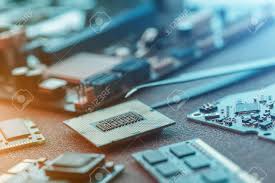RAM
 Random access memory – it is the RAM (RAM), it is also an opertivka. Serves for temporary storage of data with which the central processor works. Surely some are asking the question “why?”, Because there is a hard drive, there is memory in the processor. The answer is simple, the need to store more and more operational data is constantly growing and the processor memory (cache) is very small for that, with regards to the hard disk, some data is stored on it, but only a part, the speed of RAM is much faster than the speed of working with hard disk, because RAM is used.
Random access memory – it is the RAM (RAM), it is also an opertivka. Serves for temporary storage of data with which the central processor works. Surely some are asking the question “why?”, Because there is a hard drive, there is memory in the processor. The answer is simple, the need to store more and more operational data is constantly growing and the processor memory (cache) is very small for that, with regards to the hard disk, some data is stored on it, but only a part, the speed of RAM is much faster than the speed of working with hard disk, because RAM is used.
The main characteristics of RAM are: memory type, memory speed, timings, form factor, volume.
Type of memory – with the development of technology and computer technology, more and more types of memory appear, more precisely, newer ones remove old ones from the market. At the moment, DDR3 is common, although so far DDR2 is present. You can read about the DDR family here. In general, this is the type of memory chips themselves, but found in the names of, say, a processor or motherboard, indicates compatibility with this processor or motherboard. As a rule, each type of memory that is different, has different types of contacts, this is done not only out of “need”, but also so that it is impossible to insert DDR memory into the DDR3 slot.
Speed - memory speed is measured in MHz, in the information about the motherboard you can find instructions like, DDR3-1333, the number 1333 just shows the memory speed, this parameter is indicated so as not to make a mistake in choosing the memory. If, for example, you buy memory at a speed higher than indicated in the information about the processor or motherboard, there will be no benefit from this oversized speed, but the price will be higher. Often you can see in the memory information a record like, PC12800, this is a memory specification, but I unfortunately do not know much about it, because it is not very interesting, it is easier to ask what speed is in MHz, although it is usually written.
Timings – in fact, this is another parameter of the memory speed, usually written as “2-2-2”. The lower these numbers the faster the memory, but do not forget that lower parameters, “standard” do not indicate, as a rule, must be supported by the motherboard, otherwise there will be no use from them, and accelerated memory, as I wrote above, is more expensive.
Form factor – a form of memory execution, differ in size and number of contacts. Personal computers use DIMM memory.
Volume – measured in GB or MB, the most important parameter for memory. For computers, they now use 2-6 GB of memory, less than 2 is already small, more than 6, so far a lot, but since everything is constantly changing, I will not recommend anything concrete.
There is also one more detail, in short, the memory works better in two channel mode, i.e. it is better to use 2 memory modules, for example, you decide to take 2 GB of memory, but it will be more effective to buy 2 modules of 1 GB each.
Consider the records of RAM from the price list:
DIMM DDR3 2048MBx3 PC14400 1800MHz Kingston HyperX Intel XMP CL9-9-9-27
DIMM DDR3 – memory type
2048MBx3 – volume in MB of one module, x3 dies
PC14400 1800MHz – speed by specification and in MHz
Kingston – manufacturer
HyperX Intel XMP – lineup and lineup
CL9-9-9-27 – timings
DIMM DDR3 2048MBx3 PC12800 1600MHz Corsair XMS3 9-9-9-24 Retail
DIMM DDR3 – memory type
2048MBx3 – volume in MB of one module, x3 dies
PC12800 1600MHz – speed by specification and in MHz
Corsair – manufacturer
XMS3 – line
9-9-9-24 – timings
Retail – indicates that the boxed version
Speed - memory speed is measured in MHz, in the information about the motherboard you can find instructions like, DDR3-1333, the number 1333 just shows the memory speed, this parameter is indicated so as not to make a mistake in choosing the memory. If, for example, you buy memory at a speed higher than indicated in the information about the processor or motherboard, there will be no benefit from this oversized speed, but the price will be higher. Often you can see in the memory information a record like, PC12800, this is a memory specification, but I unfortunately do not know much about it, because it is not very interesting, it is easier to ask what speed is in MHz, although it is usually written.



